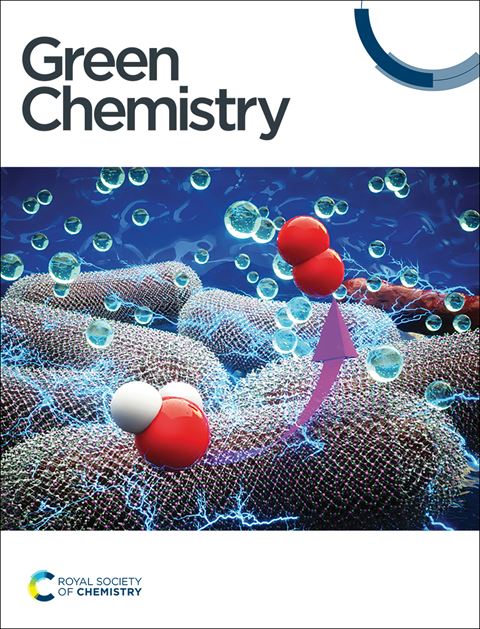用绿色溶剂萃取法从废锂离子电池中高效回收金属和制备电催化剂
IF 9.2
1区 化学
Q1 CHEMISTRY, MULTIDISCIPLINARY
引用次数: 0
摘要
随着锂离子电池生产的加速,废旧锂离子电池的退役潮也随之产生。因此,制定可持续的电池回收策略可以最大限度地减少环境污染,节约宝贵的资源。我们提出了一种简单而创新的方法,将废LiNi1−x−yCoxMnyO2 (NCM)阴极转化为镍钴硫化(NCS)电催化剂,用于析氧反应(OER)。该工艺采用绿色可重复使用的深度共晶溶剂(DESs)分离金属离子,该溶剂兼具浸出剂、金属源和模板的多重作用,简化了多阶段金属分离过程,减少了污染和浪费。然后,NCS用硫乙酰胺粘在碳纤维纸(CFP)上。所制备的NCS电极具有丰富活性位点和高表面亲水性的空心纳米棒阵列结构,可通过奥斯特瓦尔德成熟机制调节加热条件来实现。NCS电极具有良好的OER性能,过电位适中(在10 mA cm−2时η10 = 248 mV),电荷转移电阻小(2.4 Ω), Tafel斜率为67.74 mV dec−1,可稳定工作125小时。本研究为废lib回收制备多金属硫化物OER电催化剂材料提供了一条具有指导意义的可行途径。本文章由计算机程序翻译,如有差异,请以英文原文为准。

Efficient metal recovery and electrocatalyst fabrication from spent lithium-ion batteries via green solvent extraction†
The accelerated production of lithium-ion batteries (LIBs) causes the decommissioning tide of spent LIBs. Therefore, developing a sustainable battery recycling strategy can minimize environmental pollution and save valuable resources. We present an easy and innovative method to transform spent LiNi1−x−yCoxMnyO2 (NCM) cathodes into nickel cobalt sulfide (NCS) electrocatalysts for the oxygen evolution reaction (OER). This process involves separating metal ions using green and reusable deep eutectic solvents (DESs), which play multiple roles of a leaching agent, metal source and template, simplifying the multi-stage metal separation process and reducing contamination and waste. Then, NCS clings to carbon fiber paper (CFP) using thioacetamide. The prepared NCS electrode presents a hollow nanorod array structure with rich active sites and high surface hydrophilicity, which can be engineered by adjusting the heating conditions via the Ostwald ripening mechanism. The NCS electrode exhibits satisfactory OER performance, featuring a modest overpotential (η10 = 248 mV at 10 mA cm−2), small charge-transfer resistance (2.4 Ω), a Tafel slope of 67.74 mV dec−1, and stable operation for 125 hours. The new recovery technology in this work presents an instructive and feasible approach for recycling spent LIBs into multimetallic sulfide OER electrocatalyst materials.
求助全文
通过发布文献求助,成功后即可免费获取论文全文。
去求助
来源期刊

Green Chemistry
化学-化学综合
CiteScore
16.10
自引率
7.10%
发文量
677
审稿时长
1.4 months
期刊介绍:
Green Chemistry is a journal that provides a unique forum for the publication of innovative research on the development of alternative green and sustainable technologies. The scope of Green Chemistry is based on the definition proposed by Anastas and Warner (Green Chemistry: Theory and Practice, P T Anastas and J C Warner, Oxford University Press, Oxford, 1998), which defines green chemistry as the utilisation of a set of principles that reduces or eliminates the use or generation of hazardous substances in the design, manufacture and application of chemical products. Green Chemistry aims to reduce the environmental impact of the chemical enterprise by developing a technology base that is inherently non-toxic to living things and the environment. The journal welcomes submissions on all aspects of research relating to this endeavor and publishes original and significant cutting-edge research that is likely to be of wide general appeal. For a work to be published, it must present a significant advance in green chemistry, including a comparison with existing methods and a demonstration of advantages over those methods.
 求助内容:
求助内容: 应助结果提醒方式:
应助结果提醒方式:


